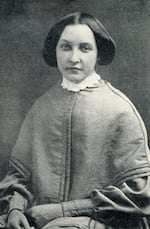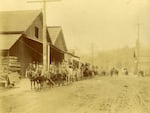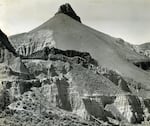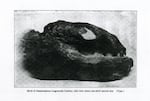In 1853 a preacher and pioneer geologist named Thomas Condon arrived in Oregon Territory. He would embrace both religion and science and devote his life to educating others about Oregon’s ancient history.
Born in Ireland in 1822 he immigrated with his family to New York at an early age. After graduating from a Presbyterian seminary in 1852, he and his new wife, Cornelia Holt, set sail for their first missionary assignment in St. Helen’s, Oregon.

A Young Cornelia Condon
Courtesy Ellen Condon McCornack
After ten years in the Willamette Valley, he was transferred to The Dalles in Eastern Oregon in 1862. At the time gold strikes across the Northwest had transformed the town into a major provisional hub for miners. Everyone heading to and from distant mining camps stopped in town to stock up on supplies. Condon’s predecessor, the Reverend William Tenney had left town six months earlier remarking that it was one of the roughest, wildest places he’d ever been. But the Condon family settled in and Thomas found a small but eager congregation that grew and thrived.

Teamsters in The Dalles
Courtesy The Oregon Historical Society, OrHi 950006
Thomas Condon always loved geology. He subscribed to scientific journals and collected rocks and fossils wherever he lived. Townspeople, teamsters, and soldiers stationed at Fort Dalles knew of his great knowledge of geology and began bringing him fossils to examine and identify.

Sheep Rock in the John Day Fossil Beds
Courtesy The Oregon Historical Society, ba013438
By 1865 Condon was accompanying the soldiers on trips into Oregon’s interior and was the first to recognize the scientific significance of the area now known as the John Day Fossil Beds – where nearly 50 million years of time are preserved.
The mid 1800s was considered the Golden Age of Paleontology. Scientists were in competition to discover fossil specimens that would support Charles Darwin’s new theory of evolution. Early on Condon had began corresponding with prominent East coast paleontologists and sent them fossil specimens he’d collected for identification. The paleontologists in turn had the status and money to write articles and get the new discoveries published in leading scientific journals.
Some of Condon’s most famous ancient discoveries included parts of small three-toed ancestors of the modern horse. Yale University professor O.C. Marsh called the fossils the “missing link” in horse evolution and would write significant papers on the subject using Condon’s fossil discoveries as part of the evidence.

"Turtle Cove" at the John Day Fossil Beds, 29 million years ago.
Courtesy University of Oregon, Museum of Natural and Cultural History
Over the years Condon’s reputation as a learned scientist grew. From the start Condon saw no conflict between his deep religious beliefs and science; and educating the public about new ideas and discoveries was of paramount importance to him. He wrote several popular articles about Oregon geology all geared to a general audience.
In 1872 the state legislature tapped Condon to become Oregon’s first state geologist. About the same time he accepted a position teaching geology at Pacific University in Forest Grove where he was named a full professor soon after. In 1876 he was appointed one of the first three original professors at the new University of Oregon and would use his large collection of fossils as teaching tools for nearly 30 years.
He would become one of the most beloved and sought after public speakers of his time and lectured extensively across the state – formally and informally – about Oregon geology and evolution.

Ancient Seal Fossil, University of Oregon Bulletin, May 1906.
In 1906 Condon would make his final discovery on the northern Oregon coast – a fossil skull of a rare ancient Pinniped, an extinct type of seal.
Today Thomas Condon’s original fossil collection lives at the University of Oregon. New discoveries are constantly being made at the John Day Fossil Beds National Monument – a wonderland he discovered and revealed to the world and where the Thomas Condon Paleontology Center welcomes all who visit.
Thomas Condon: Of Faith and Fossils was written and produced by Nadine Jelsing and edited by Bruce Barrow. It airs Monday, February 22, 2016 at 9 p.m.
Resources and Information
Articles:
- Thomas Condon, "Geological Notes from Oregon," Overland Monthly, Oct. 1869
- Thomas Condon, "The Rocks of the John Day Valley," Overland Monthly, May 1871
- Thomas Condon, "The Willamette Sound," Overland Monthly, Nov. 1871
- Thomas Condon, "A New Fossil Pinniped From The Miocene of the Oregon Coast," University of Oregon Bulletin, May 1906
Books:
- Thomas Condon, The Two Islands and What Came of Them, 1902
- Ellen Condon McCornack, Thomas Condon, Pioneer Geologist of Oregon, 1928
- Robert D. Clark, The Odyssey of Thomas Condon, 1989
- Ellen Morris Bishop, In Search of Ancient Oregon, 2003
- Elizabeth L. Orr, William N. Orr, Geology of Oregon, 1964
Websites:
- Museum of Natural and Cultural History, University of Oregon
- John Day Fossil Beds National Monument
- Thomas Condon Paleontology Center
- Columbia Gorge Discovery Center & Museum
- Historic The Dalles Oregon
- Fort Dalles Museum
